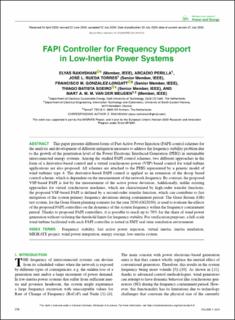| dc.contributor.author | Rakhshani, Elyas | |
| dc.contributor.author | Perilla, Arcadio | |
| dc.contributor.author | Rueda Torres, Jose Luis | |
| dc.contributor.author | Gonzalez-Longatt, Francisco | |
| dc.contributor.author | Batista Soeiro, Thiago | |
| dc.contributor.author | van der Meijden, Mart A. M. M. | |
| dc.date.accessioned | 2021-02-10T13:53:52Z | |
| dc.date.available | 2021-02-10T13:53:52Z | |
| dc.date.created | 2021-01-27T22:31:01Z | |
| dc.date.issued | 2020 | |
| dc.identifier.citation | Rakhshani, E., Perilla, A., Torres, J. L. R., Gonzalez-Longatt, F. M., Soeiro, T. B. & Meijden, M. A. M. M. V. D. (2020). FAPI Controller for Frequency Support in Low-Inertia Power Systems. IEEE Open Access Journal of Power and Energy, 7, 276-286. | en_US |
| dc.identifier.issn | 2687-7910 | |
| dc.identifier.uri | https://hdl.handle.net/11250/2727236 | |
| dc.description.abstract | This paper presents different forms of Fast Active Power Injection (FAPI) control schemes for the analysis and development of different mitigation measures to address the frequency stability problem due to the growth of the penetration level of the Power Electronic Interfaced Generation (PEIG) in sustainable interconnected energy systems. Among the studied FAPI control schemes, two different approaches in the form of a derivative-based control and a virtual synchronous power (VSP) based control for wind turbine applications are also proposed. All schemes are attached to the PEIG represented by a generic model of wind turbines type 4. The derivative-based FAPI control is applied as an extension of the droop based control scheme, which is dependent on the measurement of the network frequency. By contrast, the proposed VSP-based FAPI is fed by the measurement of the active power deviation. Additionally, unlike existing approaches for virtual synchronous machines, which are characterized by high-order transfer functions, the proposed VSP-based FAPI is defined by a second-order transfer function, which can contribute to fast mitigation of the system primary frequency deviations during containment period. The Great Britain (GB) test system, for the Gone-Green planning scenario for the year 2030 (GG2030), is used to evaluate the effects of the proposed FAPI controllers on the dynamics of the system frequency within the frequency containment period. Thanks to proposed FAPI controllers, it is possible to reach up to 70% for the share of wind power generation without violating the threshold limits for frequency stability. For verification purposes, a full-scale wind turbine facilitated with each FAPI controller is tested in EMT real-time simulation environment. | en_US |
| dc.language.iso | eng | en_US |
| dc.relation.uri | https://ieeexplore.ieee.org/document/9144273 | |
| dc.rights | Navngivelse 4.0 Internasjonal | * |
| dc.rights.uri | http://creativecommons.org/licenses/by/4.0/deed.no | * |
| dc.title | FAPI Controller for Frequency Support in Low-Inertia Power Systems | en_US |
| dc.type | Journal article | en_US |
| dc.description.version | publishedVersion | en_US |
| dc.source.pagenumber | 276-286 | en_US |
| dc.source.volume | 7 | en_US |
| dc.source.journal | IEEE Open Access Journal of Power and Energy | en_US |
| dc.identifier.doi | https://doi.org/10.1109/OAJPE.2020.3010224 | |
| dc.identifier.cristin | 1880826 | |
| cristin.ispublished | true | |
| cristin.fulltext | original | |

